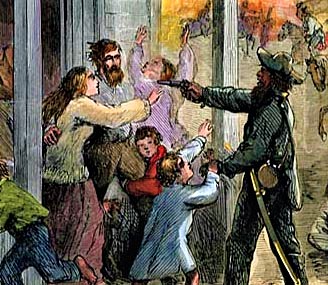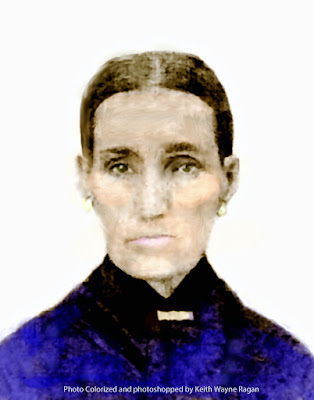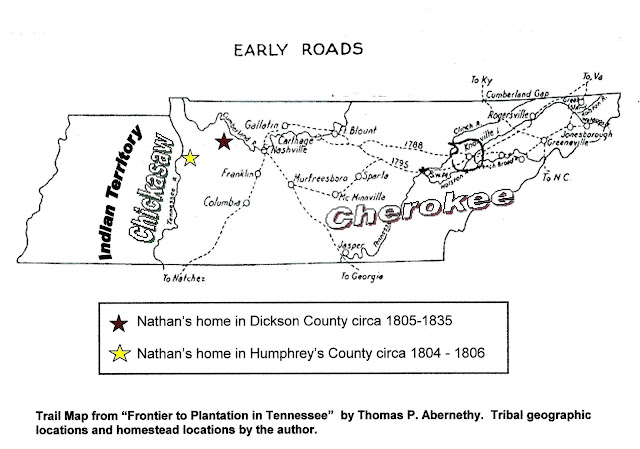OUR TARLTON STORY--PART SIX/The Murder of Alexander C. Tarlton by Southern Bushwhackers
THE
MURDER OF ALEXANDER CRAIG TARLTON BY SOUTHERN BUSHWHACKERS
Our Tarlton Story--Part Six
Foreword
In
documents first rescued from Grandma Bessie Wilson’s “burning
party” many years ago, Clarence Madison Wilson, JR., my uncle,
saved a considerable number of “papers” mostly pertaining to
Daniel Moore’s estate and passed them down to son Ronnie
Lynn Wilson .
Ronnie entrusted them to my care sometime back when I was in the
throes of ten years research on the least known of our immediate
ancestry--the Tarltons. And, as I went through each piece of paper I
came upon the original enrollment records for Alexander. They are
important in that the Missouri Data Base for Civil War Soldiers does
not include my Great-Great Grandfather Alexander Tarlton. The state’s
copies were probably among those stolen in 1866. And these records
show that on September 29, 1862, Alexander C. Tarlton was enrolled in
the service of the state and that he was assigned to Co. B, Regiment
of the Wayne County Enrolled Missouri Militia, USA. Alexander was
listed as 5’ 6’’ tall, 34 years of age, blue eyes, dark hair,
dark complexion, and born in Missouri. He was probably discharged or
exempted from this service at some point, because on April 30, 1864
the Office of Commissary of Exemptions for Wayne Co., Missouri in
Coldwater, MO. certified that Alexander had been duly enrolled again
as a militia man of the county and assigned to Company K, 68 Regiment
of Enrolled Missouri Militia. Further, he was directed to report ten
days from that date in Missouri or Tennessee. It is well documented
that he was unarmed, not on active service or having obtained
deferment the morning of his demise, and was at home with his wife
and children recovering from serious illness.
The Morning of Alexander’s Death
On
what was certainly a very cold winter morning on Sunday, December 18,
1864 Alexander C. Tarlton was sitting in his chair upright for the
first time since he was bedridden with pneumonia. He contracted
pneumonia while or shortly after a recent stock- buying trip (this
from my mother’s recollections as told to her by Susan Ann Tarlton Moore, the daughter of the subject of this narrative).
I
can imagine the stone fireplace radiating waves of welcome heat and
energy into an exhausted Alexander, lap covered with one of Mahala’s
beautiful geometric designed quilts, fine china cup of coffee in
hand. Though still weak, it was exactly one week until Christmas and
he was home with his family and not answering the militia call to go
chasing Confederate guerrillas all over the Wayne County countryside.
Baby Mary was gurgling happily. The children were thinking even
though times were hard, maybe there would be some sweet treat coming
to them in just a few short days stuffed into their Christmas
stocking hanging from their nails on the wooden mantelpiece.
Elizabeth was watching mother Mahala’s every move as she scrambled
eggs for the family breakfast and Susan was tugging on Alexander’s
pant leg, trying to get up into that warm lap and maybe beg a sip of
the rich, sweet coffee. The only milk cow remaining still provided
rich cream with the assistance of Mahala’s churn, and Susan’s
little lips pursed with anticipation of a taste of the hot, foamy
nectar.
Suddenly,
three men burst through the front door, later identified as the Dave Reed
band of Confederate guerrillas. One of the men points a pistol at
Alexander, and oral accounts say another shouted “Alexander
Tarlton, you dirty black republican, ain’t you ashamed?” In the
very next instant, in front of the horrified Mahala and all the
children, the man with the gun proceeds to fire shots into Alexander
as he stands from his chair. Other shots follow. He falls bloody, his
body in death spasms, to the warm wood floor. Screams ring out in the
room and travel through the still open door and across frost hoary
pastures and fields. Within moments the only sounds are of a woman
screaming hysterically and children crying and the distant gallop of
retreating hoofs.
Some
family members have passed down the story of the Confederate
Guerrillas trying to take the family cow away with them amidst the
howling protests of Alexander’s wife Mahala. And this may have been
the case. But, these men had ridden into a populated community,
sparsely though it may have been, of Union sympathizers and fired
gunshots surely heard by everyone for a half-mile or more, killing a
prominent member of that populace. They would be pursued surely and
quickly. It does not seem likely to me that they would or could
encumber themselves with trying to pull along a milk cow as they made
a hasty retreat to secure their lives. But, to be objective, a cow
would be a rich prize in that time of shrunken, cramping bellies for
those men in gray that day, as it would have been for almost any farm
family in Wayne County in those bleak, last days of the Civil war. It
seems more plausible, however, that the bushwhackers may have
received a command by their Captain to kill the cow and immediate
livestock as they hastened their retreat. Destroying resources that
give nourishment and comfort to the enemy was a common practice by
both armies.
Alexander’s
son George Washington Tarlton would recall to friends in his later years that he was in
the front yard that day when the guerrillas galloped onto the
property of Alexander Tarlton. At least one account states that
George and Alexander were in the front yard together. I am more
inclined to believe the story that Granny Susan Tarlton Moore repeated to my mother
on so many occasions, that Alexander was in the house at the time of
his murder. Family stories are well handed down that George, however,
was smart enough to run and hide in the hayloft as the “bushwackers”
entered the home. Certainly, George felt his life was in danger, as
must have his mother, Mahala. since he made his hasty departure from Wayne County after
his father’s murder.
The
men who murdered Alexander were recalled by both Elizabeth and her
half-brother George as being masked, and this has led to speculation
that at least one or more of the assassins were local and known by
the family. Gary Peterson, a descendant of Elizabeth, says oral
history had the location of this murder at his home near Wappapello,
Wayne County, Missouri. I find this plausible, yet puzzling.
Alexander did purchase lands in this location, part of the original
Tarlton Plantation just prior to the war. But, as stated previously
in this narrative, the 1860 census, shortly before the war broke out,
had Alexander living in his home in St Francois Township with family.
This may, in fact, have been in the Lost Creek area of future census
enumerations and seems to be another logical choice for the murder
scene to this researcher at this point in time.
Of
the properties owned by Alexander and Mahala at the time of the Civil
War, which were those used for agriculture, and which represented the
family’s home? It is still a mystery .
The
motive for Alexander’s death is not known conclusively, but was
certainly viewed as a despicable act of murder committed by guerrilla
“bushwhackers” by the local community in general and Union
sympathizers in particular. The guerrillas under Captain David Reed,
C.S.A., were greatly feared and were known to be cruel and merciless
with those from whom they “extracted justice.” Just as surely the
act would have been viewed as a justifiable and retaliatory act of
war against those who sympathized with the Union cause by the Southern partisans.
In
those last days of 1864, the Confederate guerrillas operating in
Wayne, Stoddard, Butler, Bollinger and surrounding counties were
certainly aware that their days were numbered, but this probably only
gave more urgency to settle all scores, target Union militia and
partisans, and stay alive themselves as long as was humanly possible.
After all, they held little hope for clemency or pardon after the war
was over. They became less soldier and more assassin and outlaw. Some
of the deeds of the Dave Reed band, Captain Reed himself a friend of
the infamous Sam S. Hildebrand, were of the most horrible nature of
men turned savage.
The Aftermath
Mahala
went to live in her parent’s home, probably out of fear and to
protect her family, after Alexander’s death. To be sure, Wayne
County was a dangerous place during and for many years after the
Civil War. She sold the only remaining portion of the original
Tarlton Plantation, 15.5 acres north of Wappapello, to James Smith in
1867. She was still in Meshack Ward's, her father's home on the 1870
census. In the mid-1870’s the entire Ward/Tarlton household made a
trip “out west” to the wild and wooly Kansas territories and were
enumerated in Texas County, Missouri on the special Missouri census
of 1875. Daughter Elizabeth as well as Susan’s recollections were
vivid of a trip in covered wagons until “there were no more towns.”
In all likelihood, this trip was designed around a reunion with the
family of Alexander’s brother, John Tarlton JR that had left Wayne
County at the close of the Civil War. It may be that the family knew
that John was in ill health, since John died near Alton in Oregon
County, Missouri in 1879.
In
1900 Mahala was living with brother Francis Marion Ward in Black
River Township in the home of their now deceased parents. Living
with them on the old Ward properties was Mahala and Alexander’s
son, John Meshack Tarlton and family. She lived at this home until
1906. She left the land in Black River Township to son John, and his
family. She then lived with daughter Susan Tarlton Moore and husband
Daniel in their home in the old Moore Community until her death on
January 5, 1926. She obviously was an extraordinary woman. She was so
loved by daughter Elizabeth, according to Elizabeth’s memoirs, that
on their westward journey through Kansas, Elizabeth turned down a
marriage proposal by her first love “because she couldn’t bear to
be parted from her mother.” Her grave, as previously noted, is in
Rucker Cemetery. She is a grandmother of whom every descendant should
be proud.
Conclusion
It
is apparent that our Tarlton families, their properties and fortunes
were much diminished by the Civil War in Wayne County. But, as brutal
as the act of murder upon Alexander Tarlton may seem in our eyes, the
horrific nature of the war itself reduced almost all men to
atrocities they would not have imagined themselves capable of before
the eye for an eye retaliations, ambushes, battles and feuds that
those years would produce. While the events of the war years I have
provided may seem tedious and too wordy, they are but the tiniest of
scraps of all that went on during those turbulent times, and this
rendering represents only a minute offering of the details, names,
and dates accumulated over the years.
I
don’t know if Alexander Tarlton was a kind man, or even a good man.
I have imagined he was, though. He may have been a bit formal and
stiff from his fine English upbringing, but a decent man bound by
duty and family and certainly an ambitious man as becomes apparent in
his many agricultural and real estate transactions. He must have had
the eye of the ladies. Though an average man in stature for the day, he must have been very
persuasive and cut a handsome figure to attract and secure the hands
of two such wealthy young Missouri Belles, one the daughter of an
enormously wealthy slave and land owner from New Madrid and the other
the daughter of the County Circuit Court Judge in Wayne County.
The
gravesite of Alexander is not known. Gary Peterson, a descendant of
Elizabeth, says it may be in Rucker. In the Wayne County Archives
while researching in 2011 with my brother, Ken, I came across Volume
1 of the old cemetery interments and it listed as buried in Rucker,
Alexander O. (correctly C.) Tarlton. There is no gravestone to verify
this though. Mahala is buried there, but so are her father and
mother, and Mahala died much later than Alexander. And interestingly enough, the
plot beside Mahala has been left bare, almost certainly indicating an
unmarked grave. Records say that Elizabeth Wilson Ward, wife of
Meshack, was the first person buried in Rucker Cemetery. That was in 1885, well
after Alexander’s death in 1864. And that leaves the matter as
problematical. Is the history book wrong? This cemetery was
originally known as the Ward Cemetery and owned by Mahala’s father,
Meshack Ward. Did he purchase this land to ensure not only a final
resting place for he and wife Elizabeth, but also for Alexander and
Mahala?
Regardless
of place of final repose, I find it hard to imagine that Alexander
would be buried anywhere other than in Wayne County. There is an old
cemetery mentioned in Cletis R. Ellington’s book, MINGO
referred to as General Tarlton’s Cemetery, location unfortunately
now unknown. I believe it likely that not only the resting place of
Zion (General Azion) Tarlton, his grandfather is there--my 4 times
great grandfather, but that of Alexander’s father, George as well
and probably many of the early Tarlton mothers and wives. If Ursula
Phillips Tarlton, Alexander’s first wife is there, so possibly this may
be another consideration for the final resting place for Alexander.
Maybe
Alexander lies under the cool waters of today’s Lake Wappapello or
close to it’s shores. Maybe the gravestone has fallen over and is
buried under several inches of composted leaves and topsoil in a
cemetery in the Lost Creek area, or even in old Greenville. Or his
remains may lie undiscovered amid briars and undergrowth on some
portion of the old General Tarlton Cemetery on the original Tarlton
plantation northeast of Wappapello. Since the cemetery records for Rucker include his name, I am of the opinion his remains are there right beside Mahala for eternity.
Although a person of factual research and detail, the romantic side of my nature finds it easy to imagine on cold winter mornings, heavy with frost in the
middle of December -- if you are close enough to his place of murder
and listen in total silence -- you may yet hear muted gunshots, screams
of women and children, and the crescendo of galloping hoofs. And in
the ensuing moments, the murmurs of soft weeping may yet weave their
way delicately through the mists of time in Wayne County, Missouri.
Footnote on Captain Dave Reed
David
Reed was a blacksmith in Lowndes, east-central Wayne County prior to
the war. He was very much a “Son of the South.” He joined the 2nd
Cavalry Battalion, 1st Division, Missouri State Guard, Confederate
Army, was elected Captain, and served east of the Mississippi River
in 1862 and 1863. He and most of his men deserted June 1, 1863 to
return to defend their homes, families, and personal interests in
Southeast Missouri in the manner they saw fit (personal
correspondence with Bruce Nichols). This was a common occurrence in
the regular Confederate Army as the war expanded and took many of the
men far from their families and homes. Captain David Reed would raise
a second company of men in and around Wayne County and they would
attempt to attach themselves to the 7th Missouri Cavalry Regiment.
Evidently the attachment was never approved, but the company
continued to operate in Southeast Missouri and Northeast Arkansas.
They eventually become a part of the 15th Missouri Cavalry, CSA. To
the Union citizens of Wayne and surrounding counties, he would become
leader of one of the most feared Guerilla Bushwhacker cells in the
area. He was known to be responsible for several very gruesome
killings during the war years.
I found great interest in Mr. Cletis Ellinghouse’s documentation of the
lynching by David Reed and his gang of an Ash Hill Justice of the
Peace, Thomas “Squire” Duffy probably in 1861. This was a
gruesome murder, hanging him with hickory bark to a dogwood bush.
This further served as “character reference” to the men that also
murdered Alexander C. Tarlton. Further details are provided by Mr
Ellinghouse on page 21 of his book “Mingo”.
He was paroled in June 1865 in Jacksonport, Arkansas after having suffered not one wound in the war. He became a farmer and blacksmith in Arkansas and Oklahoma, where he lived until 87 years of age. He died in Wynnewood, Garvin County, Oklahoma and is buried in King Cemetery in Mulberry, Crawford County, Arkansas.
Copyright Keith Wayne Ragan, August 1, 2009 and no reproduction of narrative or photographs in part or total in any printed form inclusive of internet and social media and ancestral websites is permitted without the express written permission of the author or his heirs. It may be reproduced or printed for private family collections for family use and reference, which is its intended purpose.






Comments
Post a Comment